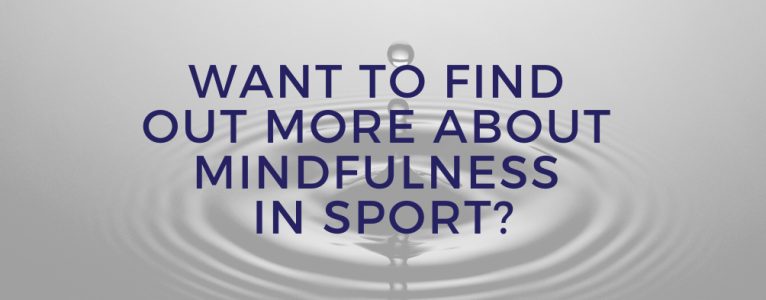The past few weeks, I have been talking to people about mindfulness and how it relates to sports people. Subsequently, today I wanted to share some more about the why, what, where, who and when of mindfulness in sport.
Let’s get started…
Why Mindfulness in Sport?
There are many reasons why practicing mindfulness can be beneficial to athletes in sport. Some of the benefits of mindfulness include –
- decreasing the symptoms of anxiety,
- allows you to access flow states (i.e. optimal human potential),
- increased life satisfaction,
- increasing a sense of empathy,
- increases in mindful attention, focus and awareness,
- decreasing symptoms of chronic pain, and
- increasing well-being.
“You might be tempted to avoid the messiness of daily living for the tranquility of stillness and peacefulness. This of course would be an attachment to stillness, and like any strong attachment, it leads to delusion. It arrests development and short-circuits the cultivation of wisdom.” ~ Jon Kabat-Zinn
What is Mindfulness?
Mindfulness in everyday life is the ultimate challenge and practice. It is a way of being, of seeing, of tapping into the full range of our humanity – often seen in playful children fully experiencing life in the here and now. Mindfulness is described by Jon Kabat-Zinn (1994)
“as paying attention in a particular way: on purpose, in the present moment and non-judgementally” (p.4).
Bob Stahl and Elisha Goldstein (2010) report “in Sanskrit, it’s known as smrti, from the root word smr, meaning “to remember” and in Pali, the language of the earliest Buddhist scriptures, it’s known as sati (mindfulness)” (p.15).
The Greater Good Science Centre at UC Berkely say –
“Mindfulness means maintaining a moment-by-moment awareness of our thoughts, feelings, bodily sensations, and surrounding environment, through a gentle, nurturing lens.”
Through the practice of mindfulness, individuals can become more aware of their thoughts, feelings and body sensations in the present moment. This observing, non-reactive perspective enables you to consciously respond with clarity and focus, rather than react out of a habitual pattern. It opens up the possibility of working more wisely with difficulties in life and choose what is nourishing to ourselves and others.
Where Can I Use Mindfulness in Sport?
Simply – everywhere! Yep, over the years (and after being an athlete) I have invested many hours researching, learning and discovering how to be a well-being. For me, one of those keys has been developing mindfulness and I use it daily in my life and wish I had learn it when I was playing tennis. Some specific ways would be –
- effectively dealing with difficulties and distractions in sport,
- communicating mindfulness with coaches, friends and family,
- using mindfulness to grow emotional literacy and intelligence,
- dealing effectively with stress, and
- enhancing self-regulation.
Who Can Use Mindfulness in Sport?
Again, simply – everyone! Yes, every athlete in every sport can benefit by using mindfulness.
When Can We Be Mindful in Sport?
Mmm – think you may be getting the drift of this! Again – in many places and some of them I have already identified above. Some other examples include –
- Failing to meet personal goals and expectations or making mistakes within their sport,
- Working through injuries and focusing on what they can do to recover,
- Managing a performance or training plateau,
- Helping you reach your full potential,
- Persisting and concentrating on what you can do (not what you can’t),
- Taking responsibility for difficult sporting experiences, and
- Keeping a balanced perspective and allowing yourself to move on.
Over to You…
I hope this post has given you some insight in to the 5W’s of Mindfulness in Sport. Over time, I have realised for myself, if I wanted to change my life, I needed to change, which is why I continue to make compassionate choices and live above the line. If you have any questions, please leave any questions or comments below.
Also – if you wanted to read more about my experience in mindfulness and self-compassion, click here. If you are ready to reclaim your courage and take the next step towards freedom and living in to your potential and flow, please feel free to join the Sport Life Flow community by clicking here.
References –
Kabat-Zinn, J. (1990). Full Catastrophe Living: Using the Wisdom of Your Body and Mind to Face Stress, Pain, and Illness. New York, USA: Bantam Dell.
Kabat-Zinn, J. (1994). Wherever You Go, There You Are – Mindfulness Meditation in Everyday Life. New York, USA: Hyperion.
Nhat Hahn, T. (2003). Creating True Peace: Ending Violence in Yourself, Your Family, Your Community, and the World. New York, USA: Simon and Schuster.
Stahl, B., & Goldstein, E. (2010). A Mindfulness-Based Stress Reduction Workbook. Oakland, USA: New Harbinger Publications, Inc.

